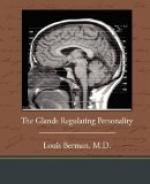At puberty, when the sex glands bloom, and the complex of the sex instincts is activated, exhibitionism manifests itself in a host of guises and disguises. Femininity in a woman, the womanly woman, or the eternal feminine, may indeed be defined by the degree of somatic and psychic exhibitionism she presents. A woman who has a delicate skin, lovely complexion, well-formed breasts and menstruates freely will be found to have the typical feminine outlook on life, aspirations and reactions to stimuli, which, in spite of the protests of our feminists, do constitute the biologic feminine mind. Large, vascular, balanced ovaries are the well-springs of her life and personality. On the other hand, the woman who menstruates poorly or not at all is coarse-featured, flat-breasted, heavily built, angular in her outlines, will also be often aggressive, dominating, even enterprising and pioneering, in short, masculinoid. She is what she is because she possesses small, shrivelled, poorly functioning ovaries. Between these two types all sorts of transitions exist, according as the other endocrines participate in the constitutional make-up. But no better examples could be given, off-hand, of the determining stamp of the internal secretions upon mind, character and conduct.
INSTINCT AND BEHAVIOUR
The sex instinct, analyzed as an endocrine mechanism, provides the clue to the understanding of all instinct and behaviour. If the post-pituitary regulates the maternal instinct, then its correlates: sympathy, social impulses, and religious feeling, must be also influenced, and so is furnished another example of a chemical control of instinctive behaviour. McDougall, once of Oxford, now of Harvard, introduced into psychology the idea of the simple instinct as a unit of behaviour, regarding the most complex conduct as a compounding of instincts. The instinct itself he analyzed into three elements: a specific stimulus-sensation, an emotion following, all ending in a particular course of muscular reaction. Translated into endocrine terms, what happens may be pictured as a series of chemical events.




